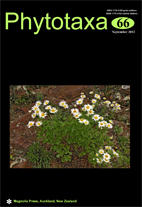Abstract
There are two morphologically similar and closely related eastern species of lizard orchids of the Eurasian Himantoglossum Sprengel (1826: 694) that, according to current literature (Sundermann 1980, Buttler 1996, Kreutz 1998, Baumann et al. 2006, Delforge 2006), can easily be distinguished by anthocyanin markings on the labella (‘lips’) of their flowers, H. caprinum (Marschall von Bieberstein 1819: 602) Sprengel (1826: 694) is said to have papillate red spots on the lip, whereas H. affine (Boissier 1882: 56) Schlechter (1918: 287) lacks such marks. We consider the length of labellar papillae as another character separating them; the former has up to 0.5 mm long papillae, whereas in the latter they rarely reach 0.1 mm. Furthermore, two quantitative morphological characters consistently mentioned in the literature are said to show little if any overlap between—and therefore be diagnostic of—the two species: (i) the length of the lateral lobe of the labellum, and (ii) the length of the labellar spur.

